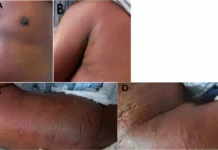A woman had successful heart surgery 6 weeks prior to landing in the emergency department. Shortly after, doctors lost her pulse, but her ECG was still showing a heart rhythm!
A sac called the pericardium encloses the heart. It is the protector of the heart. What if the protector cannot protect? An elderly woman presented to the emergency room with weakness, upper abdominal pain, and shortness of breath for 3 days. Around 6 weeks earlier, she had successful bypass surgery.
In the ER, she did not have any chest or back pain, neither any fever nor nausea and vomiting. Moreover, she denied any diarrhoea too.
The doctors examined her and found an increased heart rate and an increased respiratory rate. Additionally, her blood pressure was low. However, the oxygen saturation was 99%.
Her breath sounds were normal i.e., the lungs were clear on auscultation. However, the stethoscope did reveal faint heart sounds!
When there is fluid around the heart, the cardiac sounds can be muffled!
A portable chest x-ray showed an enlarged heart and small left pleural effusion.
ECG showed some non-specific changes and narrow QRS complex. Soon the patient became confused (decreased level of consciousness). Her blood pressure was not responding to intravenous fluids. The doctors intubated her however, she progressed to full cardiac arrest.
The doctors shocked her with a defibrillator and the doctors administered epinephrine. After one shock, her heart started to beat but she had no pulse (pulseless electrical activity (PEA)).
Thereafter, the doctors immediately inserted a needle to drain the pericardial fluid, i.e., percutaneous needle pericardiocentesis.
The procedure resulted in a collection of 60 millilitres of serosanguineous fluid and immediately she had a pulse!
However, the bedside echocardiogram still showed moderate pericardial effusion therefore, she underwent pericardiotomy, which is a procedure in which a surgical opening is made to let the fluid drain. The patient recovered and eventually the doctors discharged her.
Source: Canadian Family Physician




